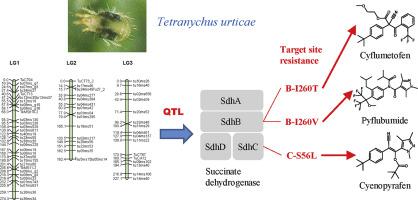Insect Biochemistry and Molecular Biology ( IF 3.2 ) Pub Date : 2020-05-19 , DOI: 10.1016/j.ibmb.2020.103410 Naoya Sugimoto 1 , Akihiro Takahashi 2 , Rei Ihara 2 , Yusuke Itoh 2 , Akiya Jouraku 3 , Thomas Van Leeuwen 4 , Masahiro Osakabe 2

|
The acaricides cyflumetofen, cyenopyrafen, and pyflubumide act as inhibitors of the mitochondrial electron transport system at complex II (succinate dehydrogenase; SDH), a new mode of action in arthropods. The development and mechanisms of low-level resistance against cyenopyrafen and cyflumetofen have been previously reported in Tetranychus urticae. In the present study, we investigated high levels of resistance against three SDH inhibitors in T. urticae field populations and clarify the genetic basis of resistance using quantitative trait locus (QTL) analysis. First, we constructed a microsatellite linkage map comprising 64 markers assembled into three linkage groups (LGs) with total length of 683.8 cM and average marker spacing of 11.03 cM. We then used the linkage map to perform QTL mapping, and identified significant QTLs contributing to resistance to cyflumetofen (one QTL on LG1), cyenopyrafen (one QTL on LG3), and pyflubumide (two QTLs on LG1 and LG3). The QTL peaks on LG1 for cyflumetofen and pyflubumide overlapped and included the SdhB locus. For cyenopyrafen resistance, the QTLs on LG3 included the SdhC locus. For cyflumetofen resistance, we found an I260T mutation in SdhB. For pyflubumide and cyenopyrafen resistance, we detected I260V and S56L substitutions in SdhB and SdhC, respectively, by direct sequencing. Both I260 in SdhB and S56 in SdhC were present in highly conserved regions of the ubiquinone binding site formed at the interface among SdhB, SdhC, and SdhD. Mutations at these positions have been implicated in resistance against fungicides that act as Sdh inhibitors in various pathogens. Therefore, we consider these mutations to be target-site resistance mutations for these acaricidal SDH inhibitors.
中文翻译:

使用微卫星连锁的QTL作图揭示了靶位点突变,该突变与对斑节对虾的三种线粒体复合物II抑制剂的高抗性有关。
杀螨剂cyflumetofen,cyenopyrafen和pyflubumide在复合物II(琥珀酸脱氢酶; SDH)(一种节肢动物的新作用方式)中充当线粒体电子传输系统的抑制剂。先前已在荨麻叶螨中报道了对氰基吡喃和氟氰脲的低水平抗性的发展及其机理。在本研究中,我们调查了对荨麻疹中三种SDH抑制剂的高水平抗药性田间种群,并使用数量性状基因座(QTL)分析阐明抗性的遗传基础。首先,我们构建了一个微卫星连锁图谱,其中包含64个标记物,这些标记物被组装成三个连锁组(LG),总长度为683.8 cM,平均标记物间距为11.03 cM。然后,我们使用连锁图进行QTL映射,并鉴定了重要的QTL,这些QTL导致了对氟美托芬(LG1上的一个QTL),cyenopyrafen(LG3上的一个QTL)和pyflubumide(LG1和LG3上的两个QTL)的抗性。氟美托芬和吡氟布胺在LG1上的QTL峰重叠并且包括SdhB基因座。对于cypyypyrafen抗性,LG3上的QTL包括SdhC基因座。对于氯氟甲酚抗性,我们在SdhB中发现了一个I260T突变。对于吡氟溴胺和氰基吡喃抗药性,我们通过直接测序分别在SdhB和SdhC中检测到I260V和S56L取代。在这两个I260 SDHB和S56在SDHC存在于在SDHB,SDHC,SDHD和之间的界面形成的泛醌结合位点的高度保守区域。这些位置的突变与对各种病原体中作为Sdh抑制剂的杀真菌剂的抗性有关。因此,我们认为这些突变是这些杀伤性SDH抑制剂的靶位点耐药突变。











































 京公网安备 11010802027423号
京公网安备 11010802027423号